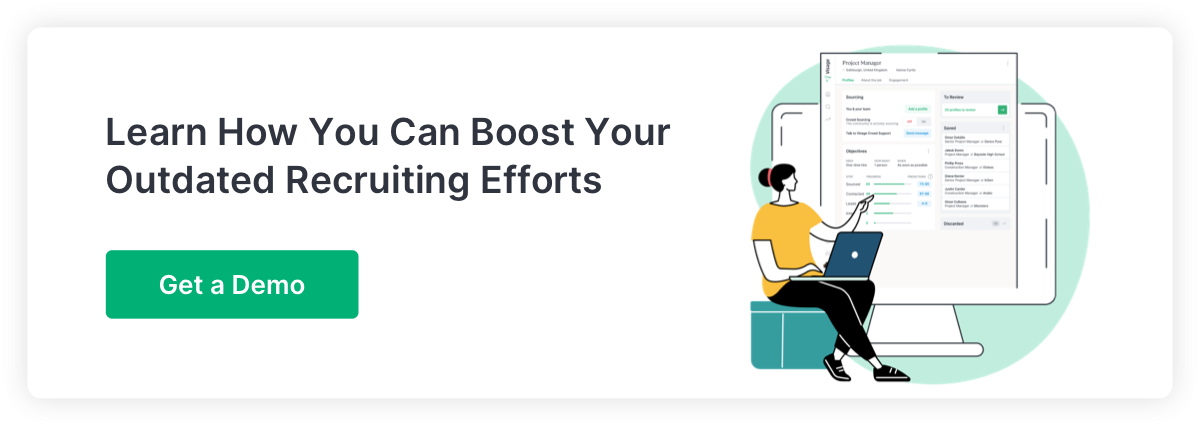You’ve spent hours crafting your sourcing email to a target candidate, but they only take a nanosecond to consign your pride & joy to the trash – or, even worse, the spam filter.
A well-crafted sourcing email that stands out in a crowded inbox can be the difference between attracting top-tier candidates and missing out on exceptional talent, but who’s got the time to spend writing awesome emails every time?
When it comes to sourcing, email templates offer recruiters an efficient strategy – simply add details to personalize your messages to potential candidates and hit “send.”
Through the Visage platform we’ve sent 592,925 emails to candidates during the past 12 months.
Why are we focusing on the last twelve months? Because the market looked a lot different in the years before. During that time we’ve been able to identify effective tactics for attracting candidates to our customers’ roles. So you can trust that what we’re sharing in this blog post contains proven practices that should help improve your response rates when it’s been the most difficult to simply catch their interest.
Our guide will give you the insights to craft email templates into awesome talent sourcing tools that capture attention and foster meaningful candidate connections – and help streamline your entire sourcing process at the same time.
Why Use Templates?
Done well, using email templates throughout the recruitment cycle will:
- Improve efficiency. Send an initial outreach email to 50 candidates in a fraction of the time it takes to write each one individually. Automation is the key to reducing recruiter burnout.
- Improve brand consistency and professionalism. Templates help maintain a consistent brand voice and image across all candidate interactions, whoever’s sending the email.
- Support scalability. Templates can easily handle bigger talent pools.
- Support improvement. It’s easy to track the success (or not) of sourcing email templates to discover which versions lead to higher response rates. For instance, recruiters can test a minor change in the subject line or body copy across a sample group to determine the most effective approach.
When To Use Templates?
Email templates can be used pretty much any time you send emails. If you want to streamline your entire recruitment process, consider developing email templates for:
- First contact with the candidate (see below for example)
- Follow-up emails with a clear call to action (e.g., “Here’s that job link I mentioned”)
- Follow-up emails to maintain engagement (e.g., “I thought you’d be interested in this webinar”) – a key part of your passive sourcing strategy
- Candidate screening
- Inviting a candidate for an interview
- Updating a candidate on their application process
- An offer
- A soft rejection that keeps the candidate in the pipeline
- Requests for feedback from candidates
- Reference checks
The downside of templates is that they can get a bad rap for being cold, generic, insincere, and repetitive. Poorly thought-out and executed recruiting templates can turn candidates off, making them feel processed – and you look uncaring.
There’s only one secret to crafting great sourcing emails: personalization. The more specifically your email addresses a candidate’s fit for a role, the more likely you are to interest them, and the more robust your talent pipeline will be.
Luckily, personalization is simple to do.
First Contact Personalization: An Example
Let’s start with an example – the recruiting email template on our platform should be your starting point. It’s flexible enough to use as is, but, by making it your own, you’ll begin building a relationship with your candidates even before your first conversation.
The good news is that customizing the template is easy. It’s already set up to address your candidate by name, but by adding in other personalization codes from our list, you can send the candidate an email that seems written especially for them – because it is.
Just because you’re using pre-set words doesn’t mean you’re not thinking specifically about their interests and what might excite them about this particular job.
Here’s how.
The Greeting
On our template, the email begins by addressing the candidate by name because no recruiting email should ever begin with “Dear candidate.” That’s a guaranteed turnoff.
Simply add your prospect’s name in the body of your email message by choosing “first name” from the variables list. One good place for it could be in your call to action. Here’s an example:
“Want to know more about us and the opportunity? Just click here, [candidate first name], and we’ll schedule a time to talk.”
Add more personal touches to show your prospect they’re not just part of some mail merge. You can use their current company, mention their current job, or both.
“As [candidate job title] with [current company] you’ve got the combination of skills and industry know-how we’re looking for.”
Tip: Avoid using “Dear” in the greeting. Except in the most formal of situations, “Hi” is a universally acceptable salutation.
Tip: Use the candidate’s name sparingly. You want it to sound natural, not contrived or forced. Repeating their name is just weird. Don’t be weird.
The Opening
Your first sentence should get right to the point. Busy people – and that’s everyone – will appreciate that you tell them up front who you are and why you’re emailing them:
“I’m a recruiter with [your company] looking for our next [job title]. After seeing your resume, I think you’d be a great fit for the job.”
Tip: Use only commonly understood job titles. You may call the position “People Operations Guru,” but “HR director” is clearer. If you really are in love with that title, explain it briefly, “… which is our head of human resources.”
The Company Description
This should be a standing part of your template. Think of it as an elevator pitch where you go beyond the simple who you are and what you do.
Rather, describe the impact your business makes. For instance, an email from a tech development company caught our eye: “We help make life easier one app at a time.”
Tip: This is about the candidate, so help them see why they should consider you. If you’re a “Best Place to Work” company, say so. But keep it brief.
The Team
Whether you’re sourcing for a company with a small workforce, where everyone is part of the same team, or for larger organizations with many employees, it’s important to give the candidate a feel for the people and a sense of the culture.
You can do that in a sentence or two, as in this example:.”
Tip: If the teams are distinct and have different responsibilities, consider customizing this section for each group.
The Job
Here’s the key part of the email. It gives your prospect the broad outlines of the job in a way that excites them about the opportunity. Remember, personalization is about the candidate. There’s a big difference between “why the job is right for you” and “why you are right for the job.”
Show your prospect it’s not just a job, but an exciting, purpose-driven opportunity that resonates with their situation, interests, and aspirations. (You’ve done your research on your candidate, right?)
Don’t be afraid to double down on details. We recently worked with an employer looking to fill entry-level positions as mortgage loan originators. The problem we faced was finding a word to describe what an originator actually does.
How interested is someone going to be if they don’t know what they’ll be doing? Just a couple of additional sentences would describe the opportunity and explain how it makes a difference in people’s lives:
Tip: Find the sweet spot between detail and brevity. Don’t make this a list. Hit only the most important and special points.
Tip: Appeal to their emotions with words by building a vision using positive words e.g.“own” a job, “join” a team.
Call To Action
It’s important to reduce the total number of “next steps” your prospect must take. Make it simple for them to take that all-important next step, which is to connect with you directly. You’ve made an effort to start building a relationship. You’ve personalized the recruiting email, and you’ve got them interested.
After all that groundwork, asking them to “apply on our website” pops the bubble of engagement. Ensure your call to action leads to real action. Linking to a passive location that requires yet another click to act is discouraging.
You’ll already have their resume and profile from Visage. So, instead of asking them to jump through the application hoop, it’s easy to make sure their next click books a call with you.
First Contact Email Templates: What To Remember
- Keep sourcing email templates short. Strive for three or four to-the-point paragraphs.
- Give as much thought to your subject line as you do the rest of the email. Make it interesting, or surprising, even – but not misleading.
- Consider sending your email outside regular business hours, when there’s less competition for attention. Weekend recruiting emails have an above-average open rate.
- Send your email template to yourself and your recruiting team to check for errors. Look for typos and odd wording, and make sure it looks good on all device types.
Sourcing Email Templates: Need More Help?
Follow the personalization strategies outlined in this guide, and you can create recruiting email templates that resonate with candidates and reflect your genuine interest in their skills and experiences – and save you hours of time!
For more help with email templates, as well as some more powerful tools (and 4,000+ global sourcers!) to source top talent at scale, reach out for a demo today.

Director of Sourcing Operations at Visage, Evelyn has experience in agency, RPO, and in-house roles spanning 12 years in the recruitment industry. Evelyn has built and oversees a 4000-member global freelance sourcing community. Every Christmas in Ireland, she enjoys putting up her THREE Christmas trees.

